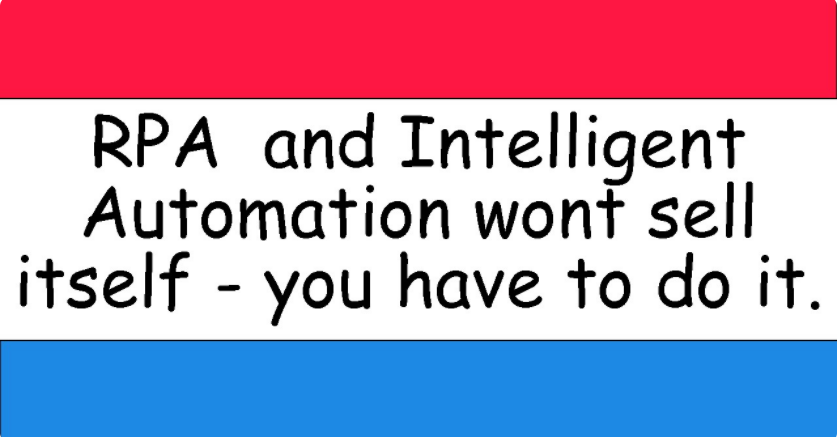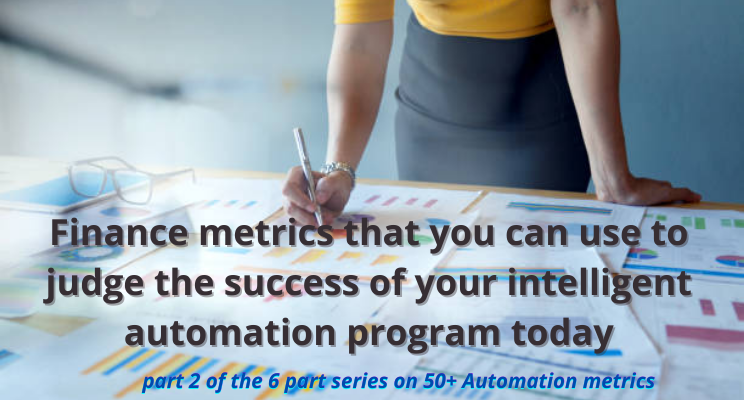Why you need to ‘sell’ RPA and Intelligent Automation to your business, and how to keep the right kind of attention needed to succeed – Part 2 of 4.
If all you have is a hammer then everything will look like a nail. It is incumbent on you to align your digital and automation strategy to a business strategy. No executive is going to sign off an digital and automation strategy that does not deliver what they business wants and needs. If you have nothing to offer then don’t expect them to offer you anything in return.
This article follows on from part 1.
Before you begin talking to your key stakeholders, understand your business strategy so you can clearly and simply align your automation ‘why’ with a business need.
Begin by understanding the organisations business strategy and understand how digital and analytics tooling might help deliver on an organisation’s business goals. If you don’t, as Simon Sinek says, understand your organisation’s ‘why’, then you cannot possibly understand ‘what’ value you need to deliver or ‘how’ you will deliver it. Once you understand your businesses ‘why’ then you can start to ‘sell’ RPA as a tool that supports deliver business outcomes.
“In Babylon we have a clear mission, to put an accessible and affordable health service in the hands of every person on earth. For that reason, through our automation program in Babylon, we target the affordable element by delivering automated solutions to reduce operational cost, increase productivity, improve operational quality and accelerate Babylon’s ability to scale globally. We have made these challenges our automation mission and our entire pipeline is created and based on it.”
Konstantinos Vogiatzakis, Global RPA Lead at Babylon Health
Book time, with key decision makers, executives, board members, senior and line of business managers. employees, HR, risk, IT and potential sponsors. Listen and explain the ‘why’, ‘what’ and ‘how’ of digital transformation e.g. extra capacity and amplified productivity; new business value from new markets or data (improved ROI or NOI); increased ability to engage and communicate with existing and new customers; ignite human ingenuity and innovation; improved customer (CX) and employee (EX) satisfaction; new innovation from Citizen Developers, etc.
Author advice note: Remember how you talk about digital transformation and what you talk about are key. Talk positively!
Too many lazy journalists or poorly informed analysts have extolled the virtues of head count reduction as being the raison d’être for investing in intelligent automation and robotic process automaton. Inevitably this has resulted in employees feeling threatened by organisations attempts to digitise.
“Stop talking about FTE savings! Look towards more impactful KPIs such as customer satisfaction, mean resolution times, increase in business/process runs etc. This isn’t about replacing people, so constantly saying ‘my robots have saved 7 FTE’ is not only off putting, but missing the point! Human augmentation not replacement delivers higher ROI. Let’s celebrate those wins!”
William Harris, Head of Intelligent Automation and AI EMEA
Therefore, paint a bright and shiny picture of the future and how everyone in the organisation can get involved to positively drive change.
Author advice note: If an organisation is able to publicly commit to not removing jobs, as a result of digitisation and automation, then this is more likely to be welcomed by its staff. Many of the best ideas for automation come from employees so their enthusiasm for the program will be key.
“Work with the ones who work on the process: this means mapping the process based on observing/recording step by step what the persons do who perform the process, They are the ones who know best what they are doing, and why”
Johannes Becker, Partner
Explain why digital transformation is key for the future of the organisation, its customers and employees. If an organisations employees don’t understand ‘what it positively means for me’ then they will not understand or engage in the path ahead. Many excellent digital transformation programs fail to deliver the benefits promised as staff become disenfranchised with the new world the don’t understand.
“Some organisations are able to inspire profound interest in their Intelligent Automation (IA) programs where others are less successful. A contributing factor is the manner in which the IA offering is articulated. In less successful organisations, the emphasis tends to focus on ‘what they do’ (features) and ‘how they do it’ (benefits):
- “We make great robots. They are user friendly, simple to manage and will make your team more efficient. Would you like to onboard one?”
More successful organisations (regardless of their size and industry) choose to inspire. Emphasis begins with ‘why they do it’ (purpose), followed by the how and what:
- “Everything we do, we believe in challenging the way work gets done, we believe in making work more human. We challenge the way work gets done by making automation more intelligent, user friendly and simple to manage, we just happen to make great robots. Would you like to onboard one?”
When organisations lead with the why – the purpose, the human element – they are talking directly to the part of the brain that controls behaviour and then it allows people to rationalise it with the tangible things they say and do.”
Lewis Walker,Intelligent Automation Architect
Don’t over promise (technology may not be the answer to your business problem) but equally highlight how successful an organisation might become when it has digitally transformed i.e. better profits, improved customer (CX) and employee (EX) experience.
Author advice note: Talk to CISO, Risk, compliance, data security and IT teams so that everyone has been considered and engaged. Talk to everyone who will listen.
Talk to your CFO. Building a business case for automation is essential. Otherwise, if you are not improving the business by spending precious money and time on digital transformation then what is the point of doing anything?
“While most organisations get absorbed in trying to get as accurate as possible with the business case, this can have a negative impact on the P&L owners. RPA or Intelligent Automation is still a new entrant in the IT landscape of most organisations and the fear of the unknown will always push the business owners towards a conservative mindset. So, keep the numbers realistic, but, account for assumptions and a reasonable stretch to absorb the additional effort which is more often that not, highly likely in a new implementation.”
Sudip Roy, Intelligent Automation Leader and Digital Transformation Strategist
There are a lot of ways to sell you digital and automation program.
Publish or send articles, podcasts, videos, magazines to leaders, managers, HR, IT, finance, risk, compliance, budget holders etc. Comment on what it is, as well as the benefits and the need for Digital Transformation and how this can benefit your organisations business goal (e.g. Deloitte’s YouTube Video ‘What is RPA?’ is excellent and fun but note: this is not a recommendation for or against Deloitte, this just happens to be a good video).
Ask you your vendor partner as they will no doubt posses a plethora of materials you can repurpose.
Talk enthusiastically and positively about the way ahead and ensure the executive team are bought in and sponsoring digital transformation is word, action, money and support.
“Head of Intelligent Automation Fireside chats, leaderships sessions, education books, business roadshows are some exemplary methods to showcase your ‘whys’ and ‘benefits’. Each of these channels should have a clear communication plan, audience and key messaging. Employees are humans and are bound to resist any new digital technologies. “Rome wasn’t built in a day” – DT leads should carefully and consistently integrate RPA, Intelligent Automation into their organisational culture.”
Tolani Jaiye-Tikolo, Senior Developer and Writer
There is a daily battle for business resources. You need to communicate how your digital and automation program is, and will continue to deliver successful business outcomes just to earn the right to stay in the game. Remember the best way to be successful, is to be successful. When you have something to talk about that clearly delivers against an organisations objectives, you are set for success. Now that you identified your key stakeholders it is time to start delivering. Part 3 discusses the proof of concept stage and ways to engage your stakeholders successfully.
What ways would you recommend to sell RPA and Intelligent Automation within your organisation?
Other articles: If you like this article then you may find these articles of use also.
- 32 real world experts outline the who, what and why when it comes to running an Intelligent Automation Centre of Expertise for FREE
- How to build a business case for Intelligent Automation and Robotic Process Automation
- 30 ways to build a pipeline of processes suitable for Robotic Process Automation (RPA) and Intelligent Automation (IA)
- The biggest lie told to RPA customers – 50 robots equals success
- If your RPA program is not making money then it has failed.
- RPA – Proof of Concept (POC) or Proof of Value (POV)? Who cares, just get going!
- 40 Essential Selection Criteria to Choose an RPA Platform – 5 part series
- I meet 150+ developers and these are 20 signs of a truly gifted developer
- The A-Z of Robotic Process Automation, Intelligent Automation and Digital Transformation
- How to scale successfully – you have 60 seconds to reply
- Can organizations implement RPA without having a digital transformation strategy – what would you have said?
- FREE training sites for Robotic Process Automation, Intelligent Automation, Data Analytics, Artificial Intelligence & Digital Training Sites
- 22 way to cut the cost of an automation program – 4 part series
If this could benefit someone else tag them and share this.
Free to reuse: We are a community of RPA, digital analytics, digital transformation and Intelligent Automation experts with years of real world experience. We have stories to tell and the scars to show for it. We share our collective wisdom for free to simply provide as much value as we can to you. Therefore, if you want to post this article on your LinkedIn page then please feel free to do so. The more information we share within the RPA community the more likely businesses are to succeed with this excellent technology.
Further Help: If I can help you in any way please do reach out.
Note: The views expressed above are our views and not those of my employer or the employers of the contributing experts.










Leave a Reply